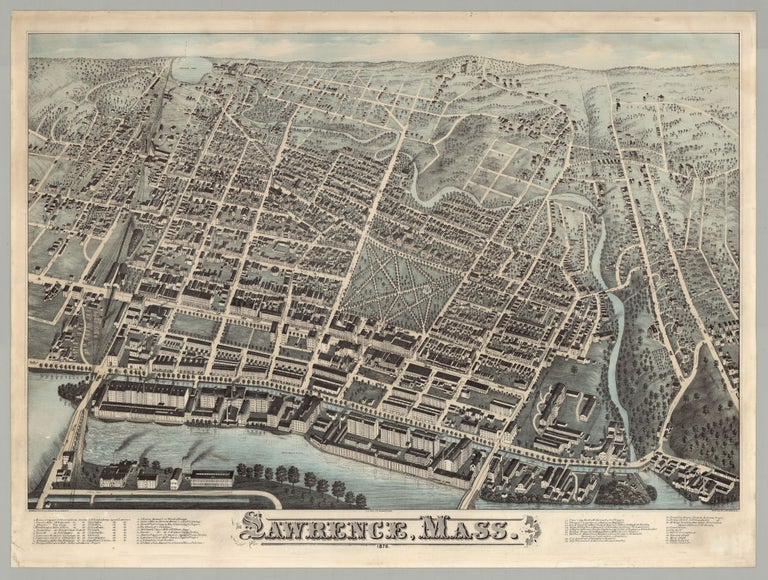Lawrence, Mass. 1876.
Milwaukee, Wisconsin: Drawn and published by H. H. Bailey and J. C. Hazen; C. H. Vogt, Lith.; Printed by J. Knauber & Co., 1876. Tinted lithograph, 20” x 30.4”, plus margins. CONDITION: Very good, light stains and toning, a few flecks of surface loss to the water in the river at lower left. A marvelous bird’s eye view of one of the great American mill towns of the nineteenth century. This view depicts the city of Lawrence from Stevens Pond at the top to a canal at the bottom, and from E. R. Haydon Coat Dealer at left to Storrow Park at right. Featured prominently in the foreground are many mill buildings lining the Merrimack River. Also depicted are churches, railroads, rivers, a park, schools, and a number of horse-drawn carriages and pedestrians populating the streets. A key in the lower margin identifies thirty-nine businesses, municipal buildings, schools, mills, the residences of noted individuals, and factories. Businesses include textile, paper and brush manufacturers, a book and stationary company, a furniture dealer, a coal dealer, and so forth. Also listed are the names of the agents for nine companies. Located twenty-five miles north of Boston, Lawrence, Mass. is the site of Bodwell’s Falls, a source of abundant waterpower, which was selected for industry in 1845 by the Essex Company, created by an association of Boston financiers including Abbott Lawrence, for whom the town was named. In 1847, the town of Lawrence was incorporated and soon developed into one of America’s largest woolen-textile centers. Lawrence constituted the nation’s first planned industrial city and by the early 20th century was a world leader in the production of cotton and woolen textiles. In 1912, Lawrence experienced a great strike led by the Industrial Workers of the World, which ended when the laborers won a one-cent hourly increase. Since 1950, the city’s industry has diversified. James Compton Hazen (1852–1908) began his career in drawing and publishing views in the early 1870s, mainly in association with H. H. Bailey. In 1877 he began working with Bailey’s brother, O. H. Bailey, a partnership that lasted until 1880. The two men also published views, in addition to the present one, of Pawtucket, Rhode Island; New Haven, Connecticut; Foxborough, Mass, and other towns and cities. From 1880 onwards Hazen published several views with E. H. Bigelow of Framingham and one final view with O. H. Bailey in 1904, depicting Lynn Woods in Lynn, Mass. Born in Ohio, Howard Heston Bailey (1836–1878) was the older brother of Oakley Hoopes Bailey (1843–1947), a prolific viewmaker, artist and lithographer active in the late nineteenth and early twentieth centuries who created over 350 city views. Oakley Bailey followed his brother’s example and the brothers are known to have worked together. Howard created a number of other views including Bird's Eye View of Concord, N.H. (1875); Bird's eye view of Pittsfield, Mass. (1876) , and Bird's eye view of Holyoke, Mass. (1877). Charles H. Vogt worked in Milwaukee from 1870 to 1879 and then in Cleveland with his son for the next decade as Vogt & Son until 1889. Born in Germany, Jacob Knauber (1846–1905) was active in Milwaukee and produced city views as well as trade cards. J. Knauber & Co. operated from 1868 to the 1940s. REFERENCES: Last, Jay. The Color Explosion: Nineteenth-Century American Lithography (Santa Ana, CA, 2005); “Explore Lawrence” at Essex Heritage online; “Lawrence Massachusetts” at Britannica online.
Item #6390
Sold


